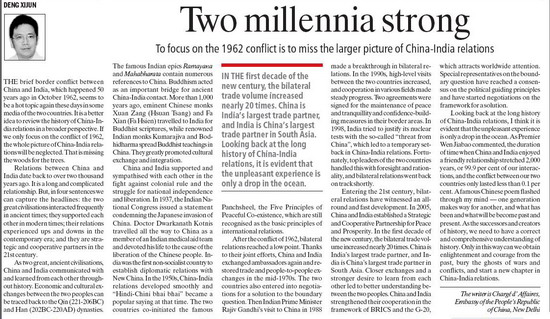|

Issued in The Indian Express, October 27, 2012
By Deng Xijun, Chargé d’ Affaires of the Embassy of the People’s Republic of China in India
The brief border conflict between China and India, which happened 50 years ago in October 1962, seems to be a hot topic again these days in some media of the two countries. It is a better idea to review the history of China-India relations in a broader perspective. If we only focus on the conflict of 1962, the whole picture of China-India relations will be neglected. That is missing the woods for the trees.
Relations between China and India date back to over two thousand years ago. It is a long and complicated relationship. But, in four sentences we can capture the headlines: the two great civilisations interacted frequently in ancient times; they supported each other in modern times; their relations experienced ups and downs in contemporary era; and they are strategic and cooperative partners in the 21st century.
As two great ancient civilisations, China and India communicated with and learned from each other throughout history. Economic and cultural exchanges between the two peoples can be traced back to Qin (221—206BC) and Han (202BC—220AD) dynasties. The famous Indian epics Ramayana and Mahabharata contain numerous references to China. Buddhism acted as an important bridge for ancient China-India contact. More than 1000 years ago, eminent Chinese monks Xuan Zang (Hsuan Tsang) and Fa Xian (Fa Hsien) travelled to India for Buddhist scriptures, while renowned Indian monks Kumarajiva and Bodhidharma spread Buddhist teachings in China. They greatly promoted cultural exchange and integration .
China and India supported and sympathised with each other in the fight against colonial rule and struggle for national independence and liberation. In 1937, the Indian National Congress issued a statement condemning the Japanese invasion of China. Doctor Dwarkanath Kotnis travelled all the way to China as a member of an Indian medical aid team and devoted his life to the cause of the liberation of the Chinese people. India was the first non-socialist country to establish diplomatic relations with New China. In the 1950s,China-India relations developed smoothly and "Hindi-Chini bhai bhai" became a popular saying at that time. The two countries co-initiated famous Panchsheel, the Five Principles of Peaceful Co-existence, which are still recognised as the basic principles of international relations.
After the conflict of 1962, the bilateral relations reached a low point. Thanks to their joint efforts, China and India exchanged ambassadors again and restored trade and people-to-people exchanges in the mid-1970s. The two countries also entered into negotiations for a solution to the boundary question. Then Indian Prime Minister Rajiv Gandhi's visit to China in 1988 made a breakthrough in bilateral relations. In the 1990s, high-level visits between the two countries increased, and cooperation in various fields made steady progress. Two agreements were signed for maintenance of peace and tranquillity and confidence- building measures in their border areas. In 1998, India tried to justify its nuclear tests with so-called "threat from China", which led to a temporary setback in China-India relations. Fortunately, top leaders of the two countries handled this with foresight and rationality, and bilateral relations went back on track shortly.
Entering into the 21st century, bilateral relations have witnessed an all round and fast development. In 2005, China and India established a Strategic and Cooperative Partnership for Peace and Prosperity. In the first decade of the new century, the bilateral trade volume increased nearly 20 times. China is India's largest trade partner, and India is China's largest trade partner in South Asia. Closer exchanges and a stronger desire to learn from each other led to better understanding between the two peoples. China and India strengthen their cooperation in the framework of BRICS and G-20, which attracts worldwide attention. Special representatives on the boundary question have reached a consensus on the political guiding principles and have started negotiations on the framework for a solution.
Looking back at the long history of China-India relations, I think it is evident that the unpleasant experience is only a drop in the ocean. As Premier Wen Jiabao commented, the duration of time when China and India enjoyed a friendly relationship stretched 2,000 years, or 99.9 per cent of our interactions, and the conflict between our two countries only lasted less than 0.1 per cent. A famous Chinese poem flashed into my mind—one generation makes way for another, and what has been and what will be become past and present. As the successors and creators of history, we need to have a correct and comprehensive understanding of history. Only in this way can we obtain enlightenment and courage from the past, bury the ghosts of wars and conflicts, and start a new chapter in China-India relations.
|